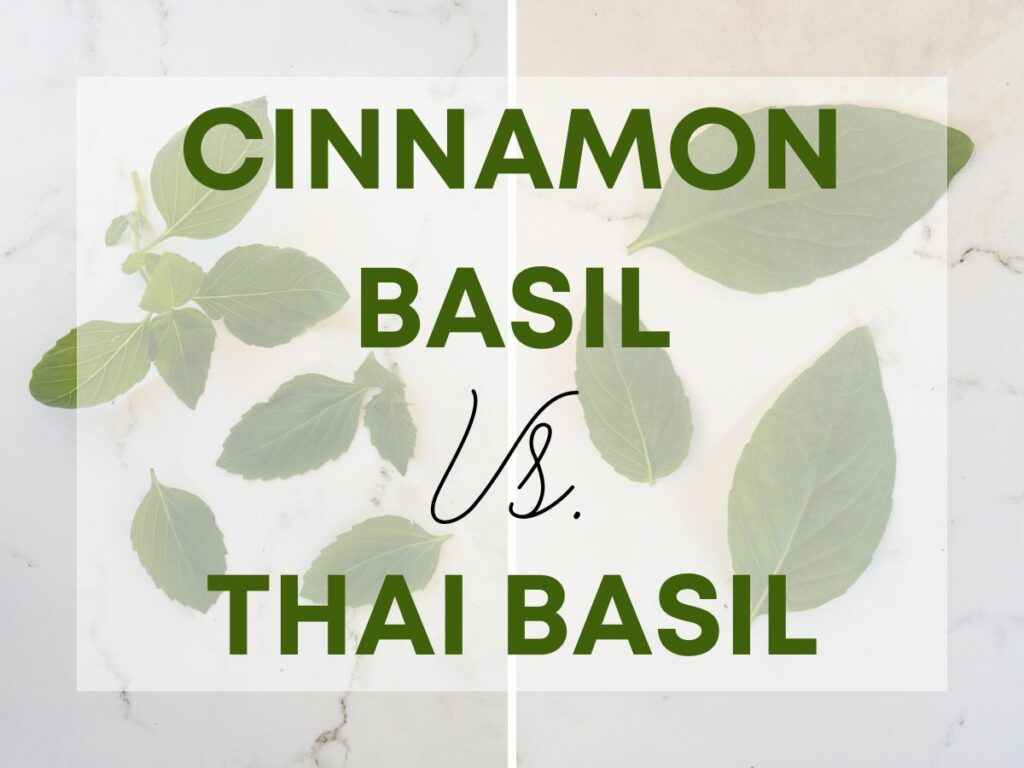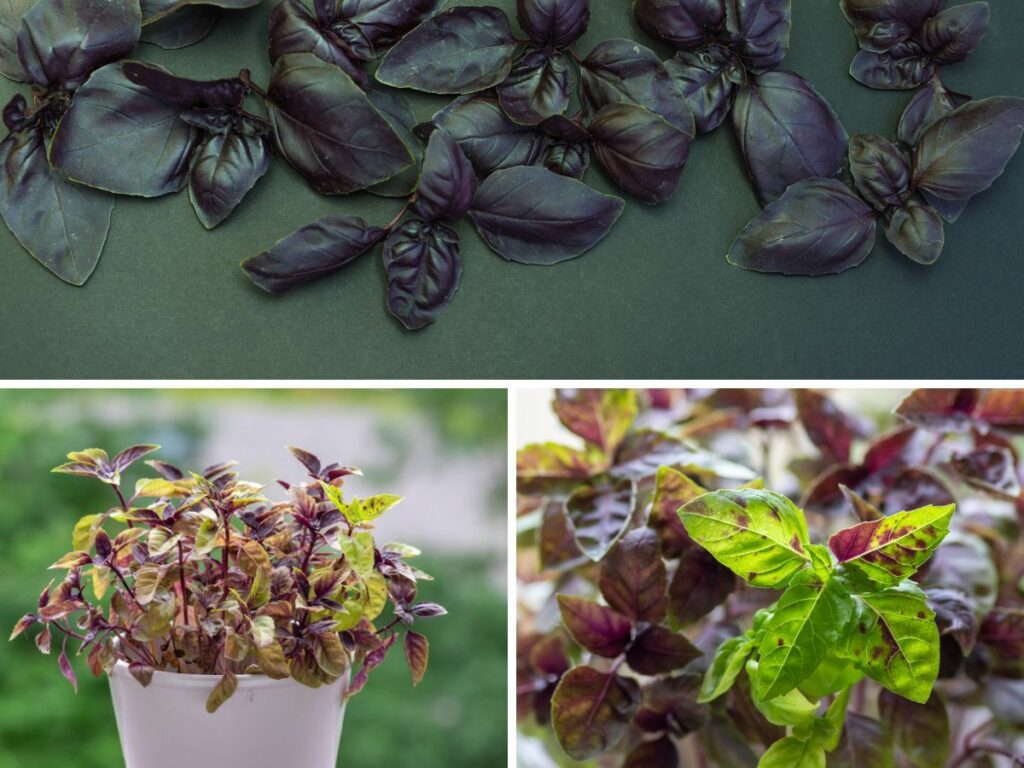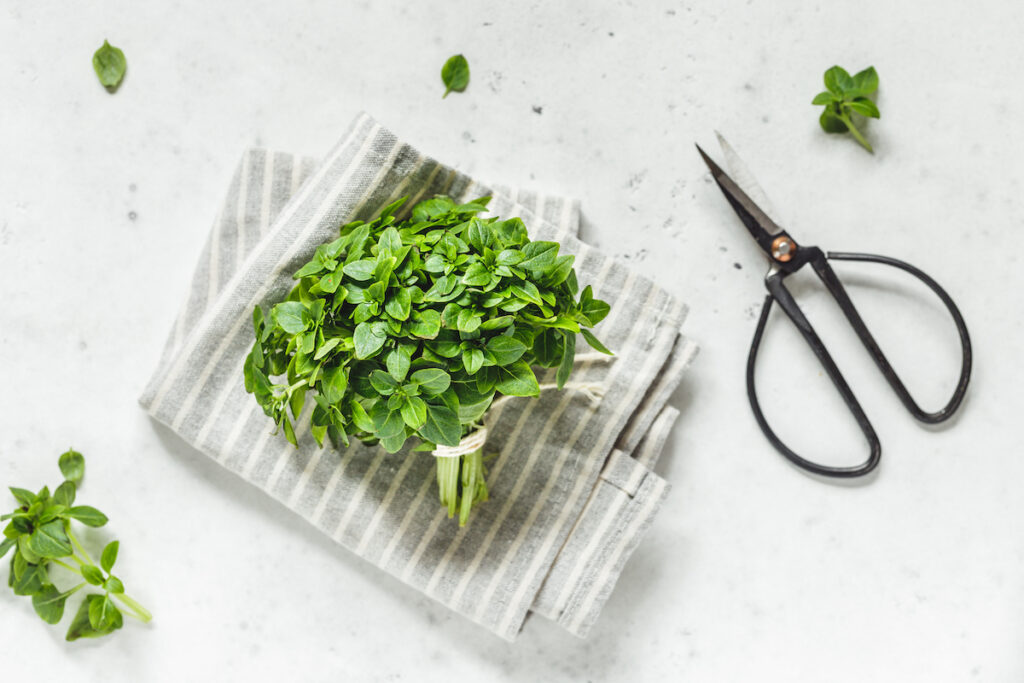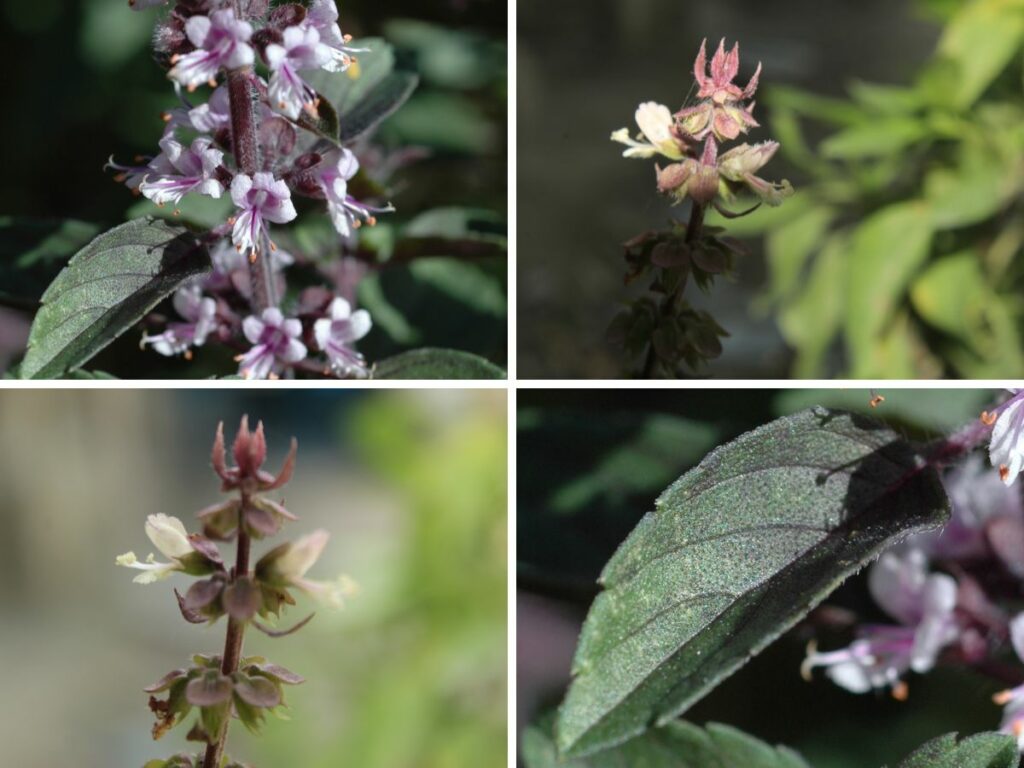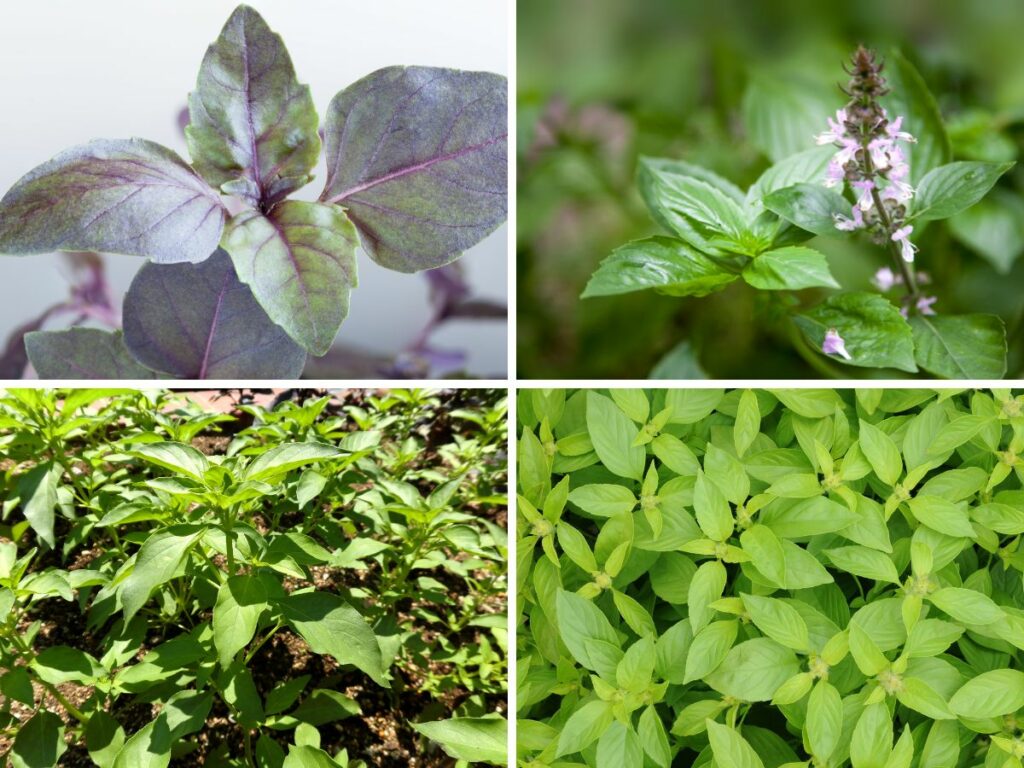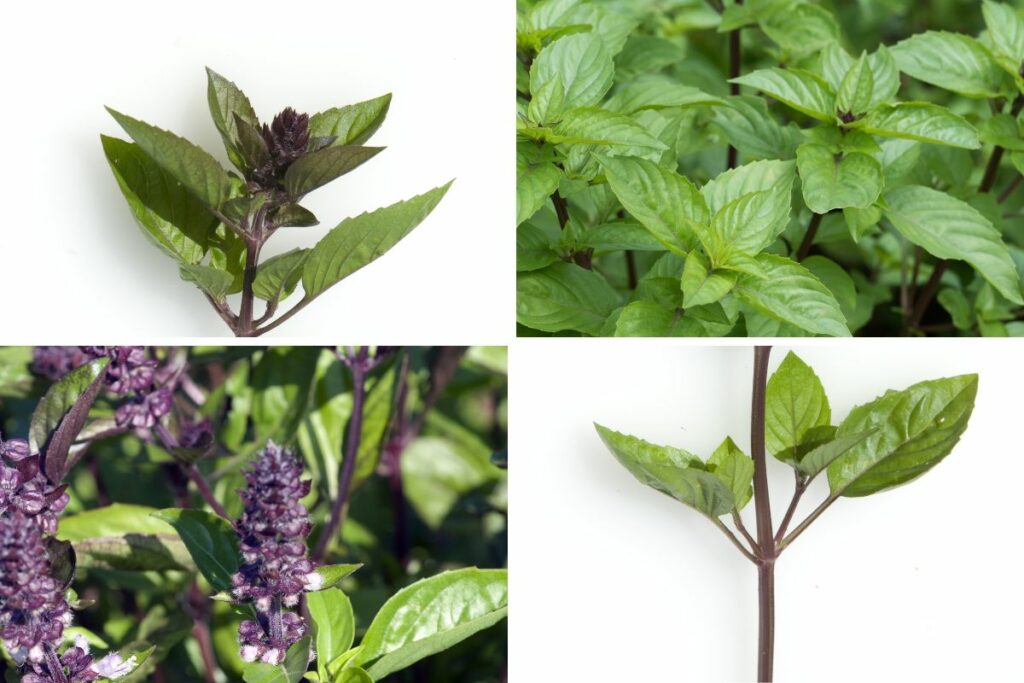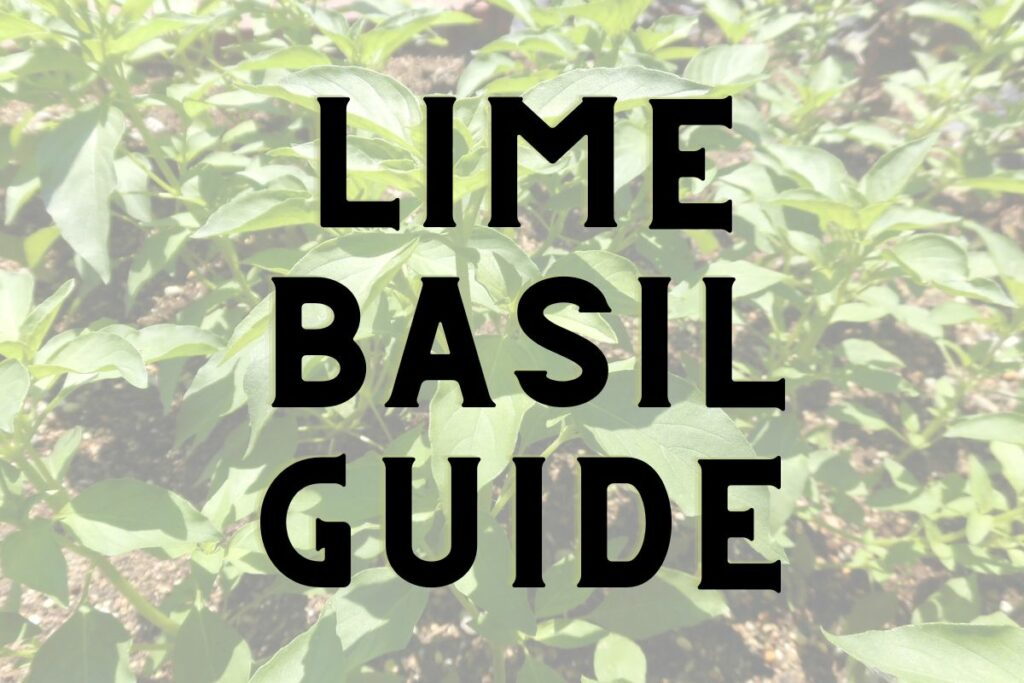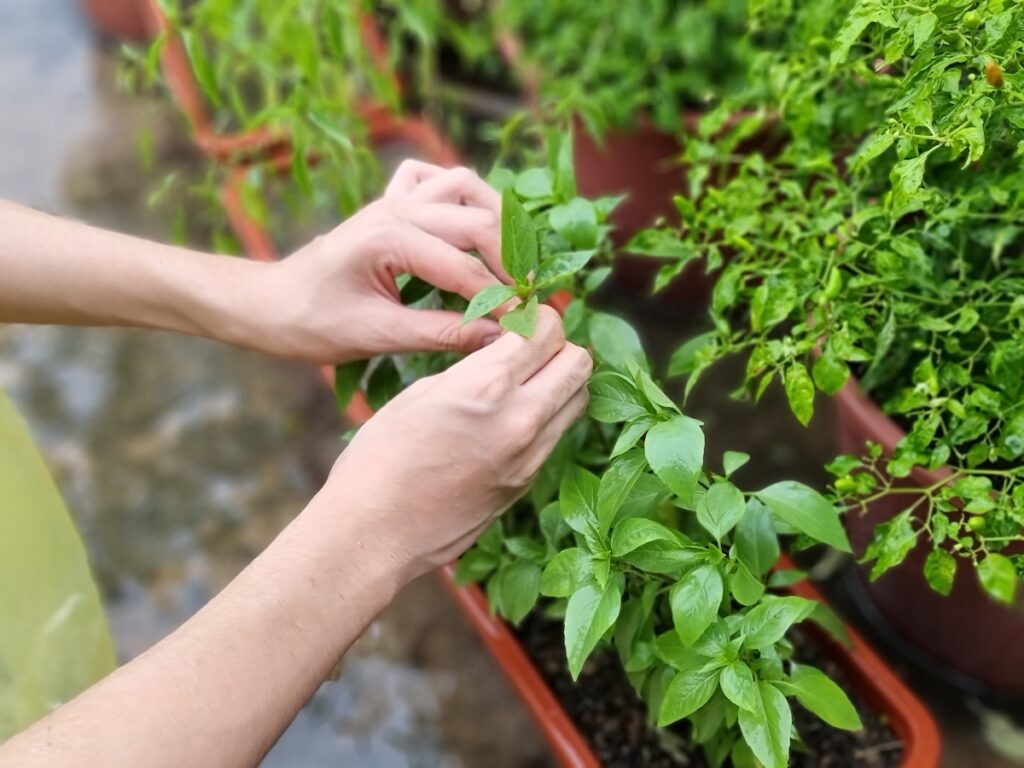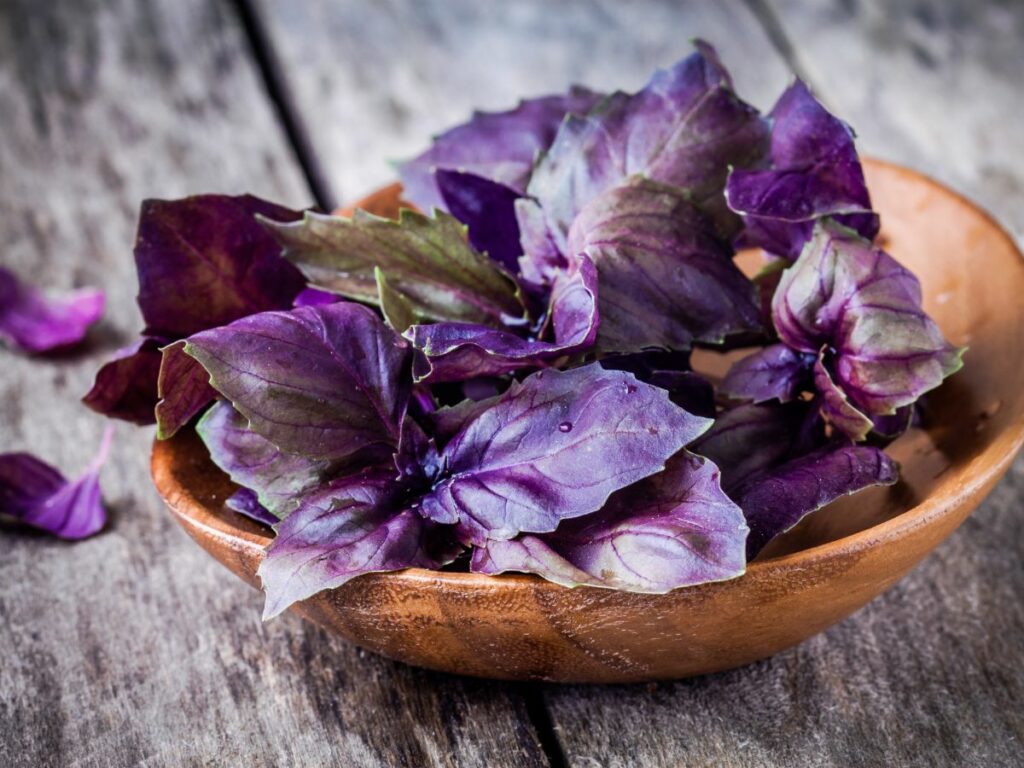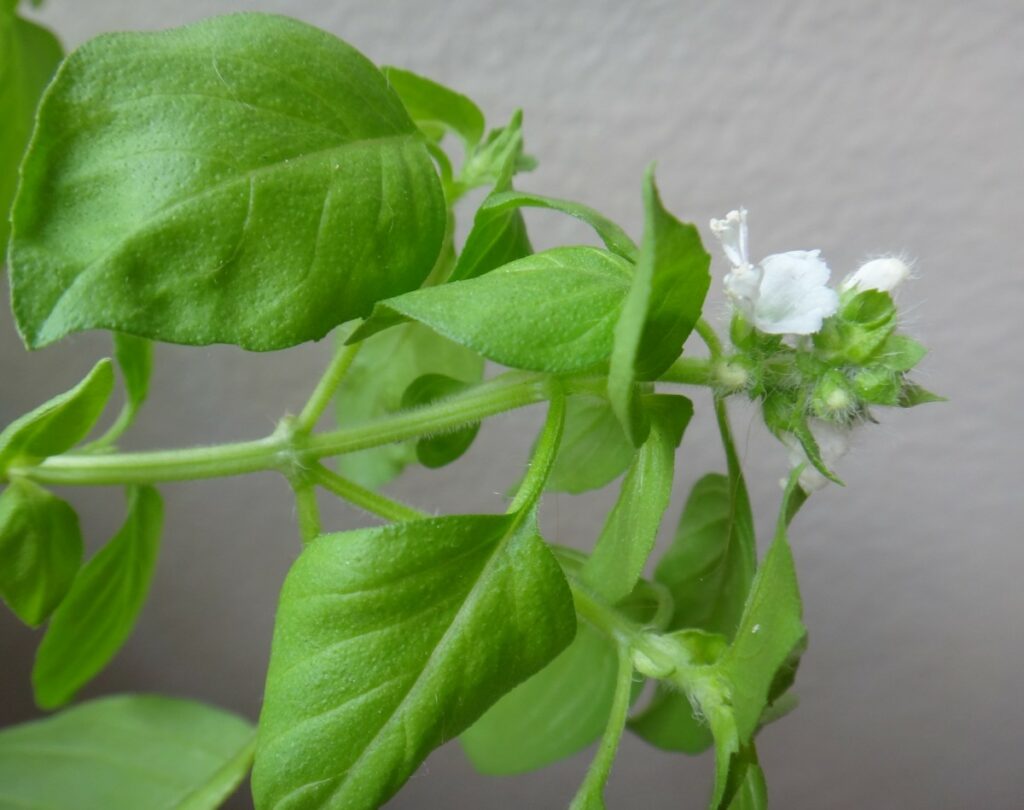An Overview of Different Types of Basil and Basil Varieties
Types of Basil
As an Amazon Associate I earn from qualifying purchases. This website also participates in other affiliate programs and may earn commissions if you shop through the links used on this website.
We’re pretty much all familiar with sweet basil, the gorgeous and aromatic flavor we love on pizza, pesto, pasta dishes and Caprese salads. But did you know there is actually huge diversity when it comes to all the varieties of basil? Green basil, blue basil, purple basil, red basil…even magical…all the types of basil could practically makeup a whole rainbow!
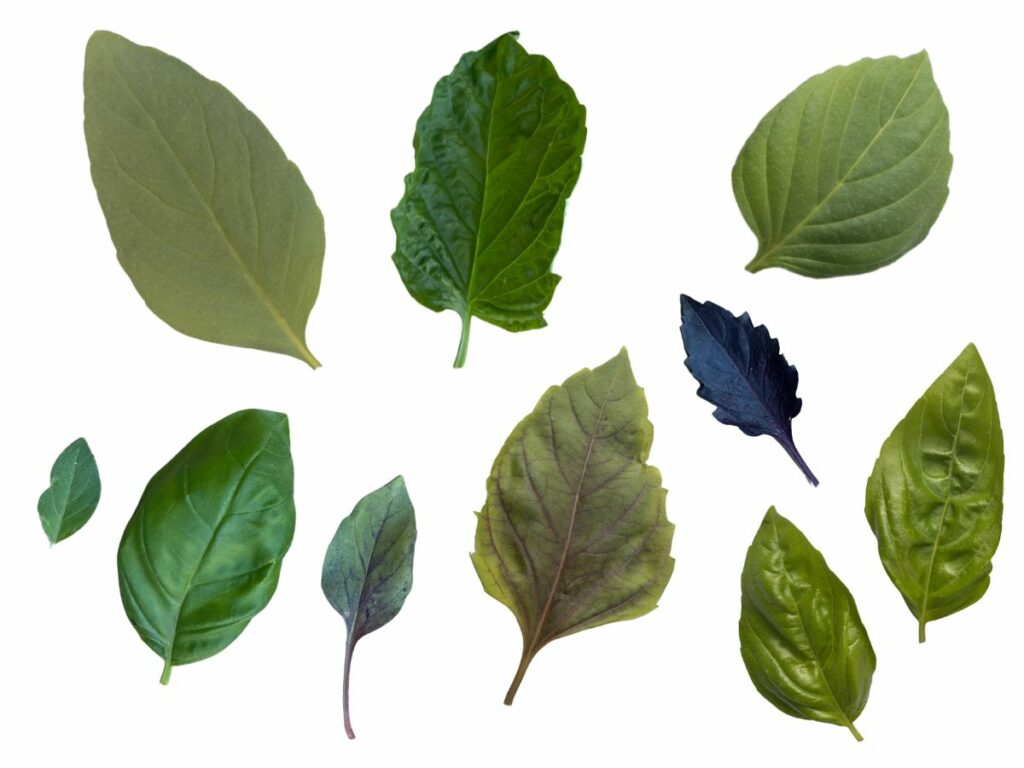
Table of Contents

How Many Types of Basil Are There?
The different types of basil can be broken up into cultivars, hybrids, and similar species. There are more than 60 cultivars in addition to hybrids and similar species, putting a “best guess” at how many varieties of basil there are somewhere around 100.
One of the most popular culinary herbs in the world, the huge variety of basil available – and its aromatic scents and flavors – is great news for adventurous gardeners and cooks.
Sweet Basil Cultivars (Ocimum basilicum)
Ocimum basilicum, aka Sweet Basil, is the type of basil most North Americans are familiar with. It’s what most of us pick up when we buy basil in the supermarket or garden store, and is widely produced at scale for commercial use.
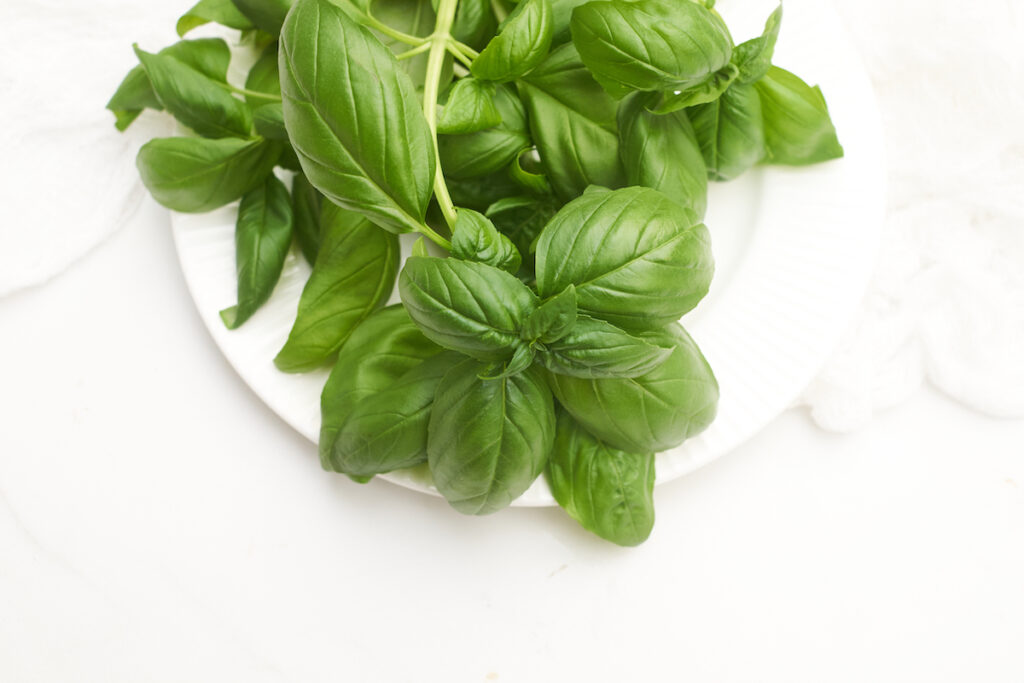
Because of the sheer quantity of sweet basil cultivars, the exact taxonomy is uncertain, and can be confusing, as the same latin names and common names / nicknames are often used to describe different cultivars, and broader category names (i.e. lettuce leaf basil or simply lettuce basil) are often used to interchangeably or in place of more specific names (such as Tuscany basil, Napoletano basil, Mammoth basil, or large leaf basil, for example).
The huge variety of ocimum basilicum cultivars also expands regularly, given that basil is a frequent cross-pollinator, creating hybrid plants.
Basil Hybrid Plants (Ocimum basilicum x)
Beyond the 60+ known sweet basil varieties, there are also a number of basil hybrids, whereby a cultivar of ocimum basilicum cross-pollinated with another species.
African blue basil (Ocimum basilicum × O. kilimandscharicum) is an example of a basil hybrid, and is notable because it’s a sterile hybrid that can only be grown via cuttings.
Lemon basil is another hybrid of sweet basil and lime basil or American basil (Ocimum basilicum × O. americanum).
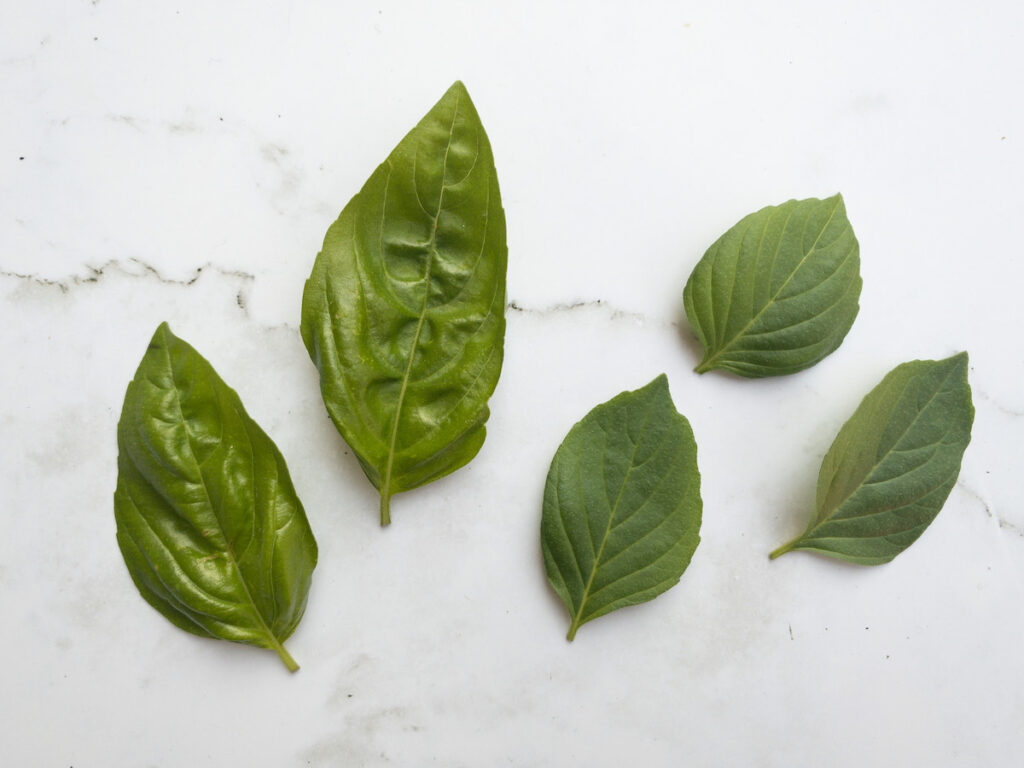
Similar Species: Camphour Basil, Holy Basil, Spicy Basil, Bush Basil etc.
Whereas sweet basil and its cultivars are Ocimum basilicum, some basils are different species all together. These include but aren’t limited to:
- Holy basil (Ocimum tenuiflorum)
- Bush basil or dwarf basil (Ocimum minimum)
- Wild basil (Clinopodium vulgare)
- Camphor basil (Ocimum kilimandscharicum)
Additional Confusion
Again, due to the massive number of basil cultivars, hybrids, and similar species which are nonetheless referred to as basil, as well due to the fact that basil is used around the world in different cultures and countries in different ways, there are some basils that have multiple names, and sometimes more than one type of basil share the same name.
Lemon basil is referred to by different sources as Ocimum basilicum × O. americanum OR Ocimum citriodorum.
Both lemon basil and lime basil are sometimes referred to as hoary basil.
There are also basil varieties that are so similar, they’re widely confused or referred to as the same plant on the internet, despite being different (i.e. Greek Columnar Basil and Aussie Sweetie Basil).
Finally, sometimes we just don’t know what type of basil a plant is. For the average gardener or cook, this is probably okay. We can make an educated best guess about what we find in a herb garden. The reality is we simply have to do the best we can when talking about or describing the different basil varieties.
What are the Different Types of Basil and Uses?
Italian Basil
Sweet Basil (Ocimum basilicum)
Common sweet basil is the type of basil most North Americans are familiar with. It’s what we’re most likely to pick up in the supermarket or garden centre, and most likely to reach for to toss on top of pizza or use in pesto.
Genovese Basil (Ocimum basilicum ‘Genovese’)
Genovese basil is a cultivar of sweet basil, with slightly larger, flatter and pointier leaves. It is more or less used interchangeably with sweet when it comes to the kitchen, and if a recipe calls for fresh basil, you can use sweet or genovese basil.
Italian Large Leaf Basil
Another popular cultivar of O. basilicum, Italian large leaf basil has a largely similar taste to sweet or Genovese, but with larger leaves and less of a pepper taste. Commonly used in Napoletano cooking.
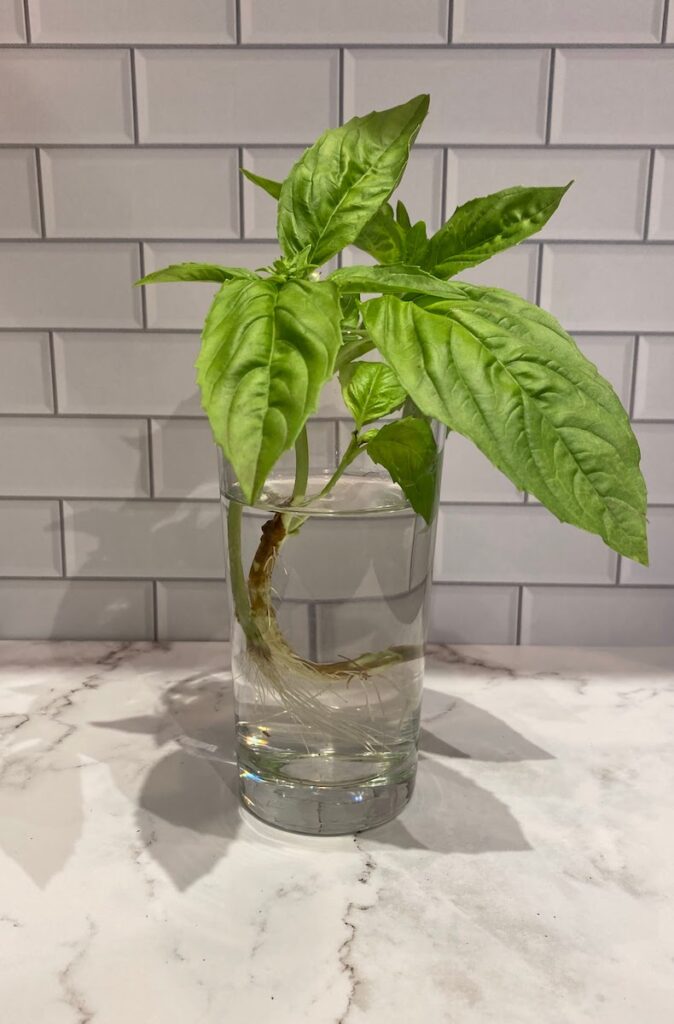
Tuscany Basil (Ocimum basilicum Toscano)
A lettuce basil cultivar native to Italy’s Tuscany region, with large crinkly leaves and slightly milder flavor than Genovese. Great in Italian cooking, in particular pestos, Caprese salads, lettuce wraps, and other fresh dishes.

Napoletano Basil (Ocimum basilicum ‘Neapolitan’)
An heirloom variety of Ocimum basilicum (sweet basil) native to Naples, Italy, where it’s referred to as bolloso and used in abundance as a culinary herb. Napoletano basil has a traditional Italian basil flavor that works well in many Italian dishes. It has large, crinkly and ruffled leaves reminiscent of lettuce leaves, and is great in pesto and Caprese salad.
Lettuce Leaf Basil (Ocimum basilicum Crispum)
A heirloom sweet basil variety that’s more than 100 years old, this type of basil has large crinkly leaves and a milder flavor than sweet or Genovese. It’s great fresh, used in salads and wraps, and is relatively slow to bolt (flower) giving growers a longer harvest window.
Mammoth Basil (Ocimum basilicum crispum Monstruoso)
A lettuce leaf cultivar that produces massive green leaves with a distinctive crinkled or blistered look, and ruffled edges. The plant can grow up t0 24″ tall (61 cm) and 18″ wide (45 cm). Mammoth basil has a similar taste to sweet basil or Genovese and is great in fresh salads, sandwiches, on burgers and in pesto.
Green Ruffles (Ocimum basilicum ‘Green Ruffles’)
Green ruffles leaves are longer and narrower than a “normal” basil leaf, with a serrated edge. They look more reminiscent of a dandelion leaf than a Genovese leaf! The leaves are tangy and aromatic, with more complex notes than in a standard sweet basil, and undertones of citrus fruits, liquorice, and cinnamon.
Red Lettuce Leaf Basil (Ocimum basilicum ‘red lettuce leaf’)
Another ocimum basilicum cultivar with large, crinkled leaves, red lettuce basil has purple or purple and green mottled leaves, and adds a gorgeous splash of herbaceous flavor and color to salads, sandwiches, wraps, and as a garnish.
Napoletano Basil (Ocimum basilicum ‘Neapolitan’) and Tuscany Basil (Ocimum basilicum Toscano)
Covered above, these are both Italian basils, but are also considered lettuce basil.
Dark Opal Basil (Ocimum basilicum ‘Dark Opal’)
A sweet cultivar developed at the University of Connecticut in the 1950s, dark opal basil has gorgeous dark purple leaves, or mottled purple and dark green leaves that are highly aromatic. Best used raw, as the leaves change to a black color when cooked for too long. Throw them into a pesto or Caprese salad for an unexpected look, or grow them as a decorative herb in your garden.

Purple Ruffles Basil (Ocimum basilicum var. purpurascens ‘Purple Ruffles’)
Purple Ruffles basil produced beautiful leaves that are large, ruffled and serrated on the edges, with a shiny dark, rich purple color. The leaves don’t look like typical basil leaves, and have a milder taste than supermarket or Genovese basil, with more liquorice or anise undertones. Great to throw into a salad, sandwich or burger for its show-stopping looks!
Amethyst Basil (Ocimum basilicum ‘Amethyst’)
Amethyst basil has a similar leaf shape to standard basil, and similar taste as well. When young, the leaves are a beautiful dark purple. As the plant matures, the leaves become more mottled, with deep purple veins surrounded by green leaves.
Osmin Purple Basil
Native to Switzerland, Osmin basil has the deepest purple coloring of all the purple basils. It’s also faster growing than many basils, offering a bountiful harvest to use in vinegars, fresh meals, and as a garnish on cocktails, pastas, chicken dishes, etc.
Red Rubin Basil (Ocimum basilicum var. purpurascens)
Despite its name, Red Rubin basil is actually a purple basil, not red. With purple stems and purple or purple-green mottles leaves, Red Rubin basil has a similar taste to sweet, but more pungent and with more notes of clove.
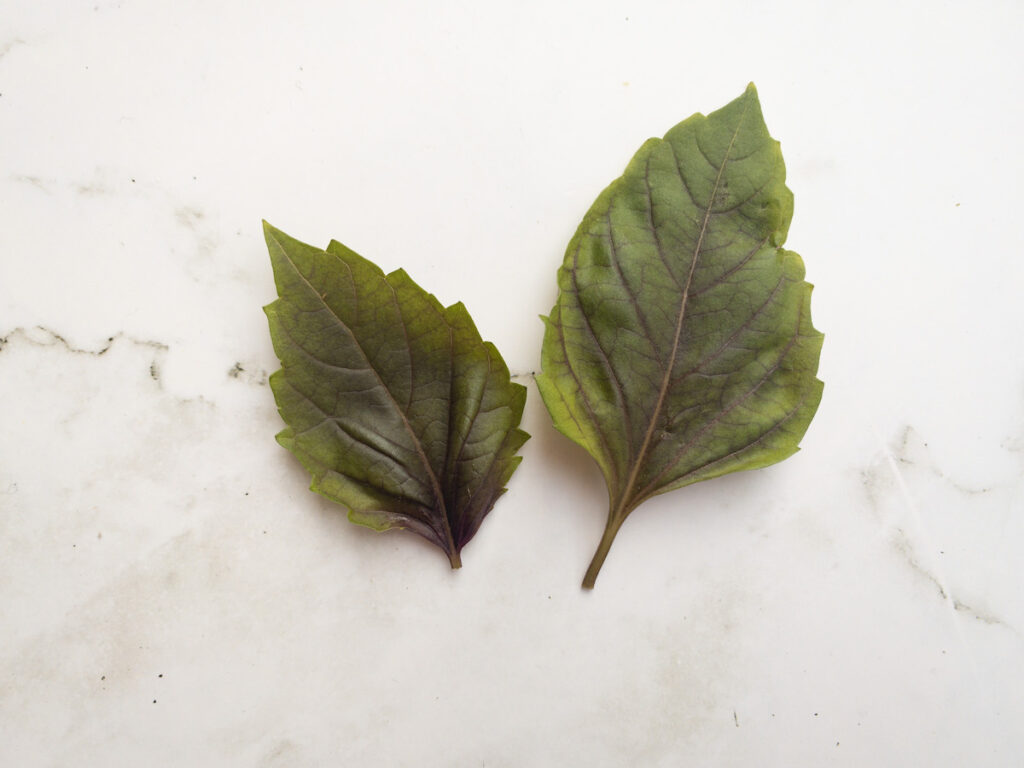
Types Citrus Basils
Lime Basil (Ocimum americanum)
Also known as American basil, or hoary basil, Lime Basil is not, in fact, native to America, hailing from African, Southeast Asia, India and China. This plant is highly fragrant, with citrus notes that give it a lovely lime-like flavor when eaten or used in cooking. This plant has deep roots, making it less suitable to a container garden than some other types of basil.
Lemon Basil (Ocimum basilicum × O. americanum / Ocimum citriodorum ‘Lemon’)
Lemon basil also goes by the names Thai lemon basil, Lao basil, and – confusingly – hoary basil (as does Lime basil). This plant is a cross between Ocimum basilicum and Lime basil or American basil (Ocimum americanum). As might be expected from the name, it has a citrusy aroma and flavor reminiscent of lemon.
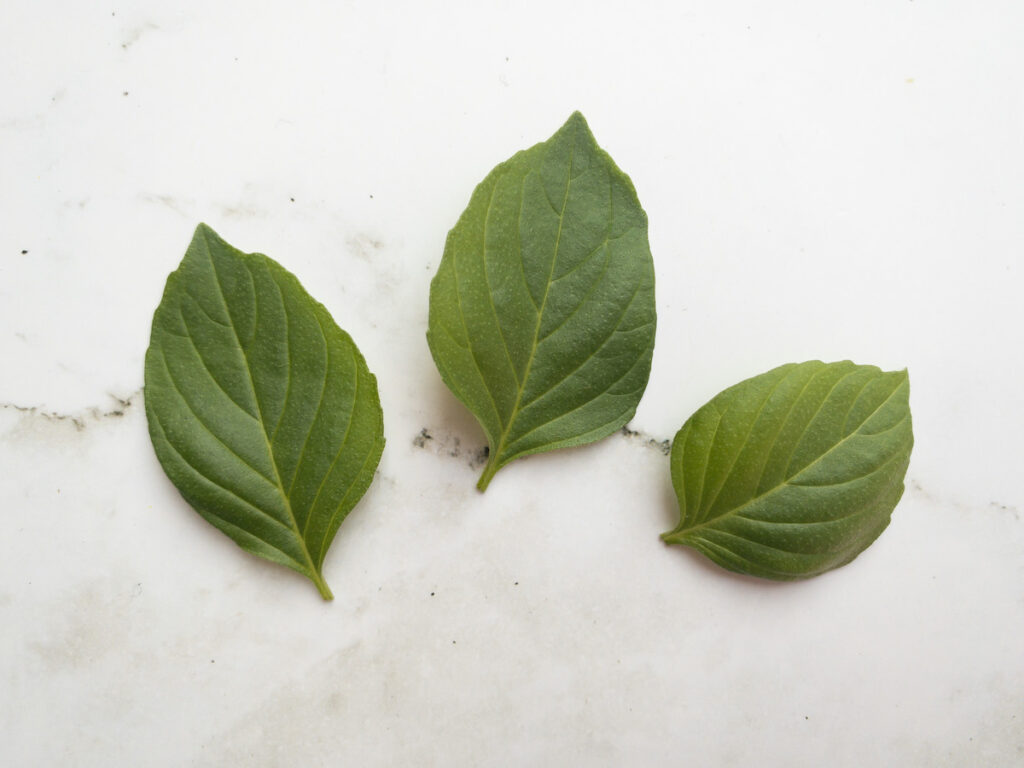
Mrs Burns Lemon (Ocimum basilicum var. citriodora)
Whereas Lemon basil is a cross between Ocimum basilicum and Ocimum Americanum, Mrs Burns Lemon Basil is a cultivar of Ocimum basilicum, not a hybrid. Depsite this, it also has a wonderful citrus aroma and flavor that makes it a great addition to your kitchen or edible garden. The flowers are also lovely in floral arrangements.
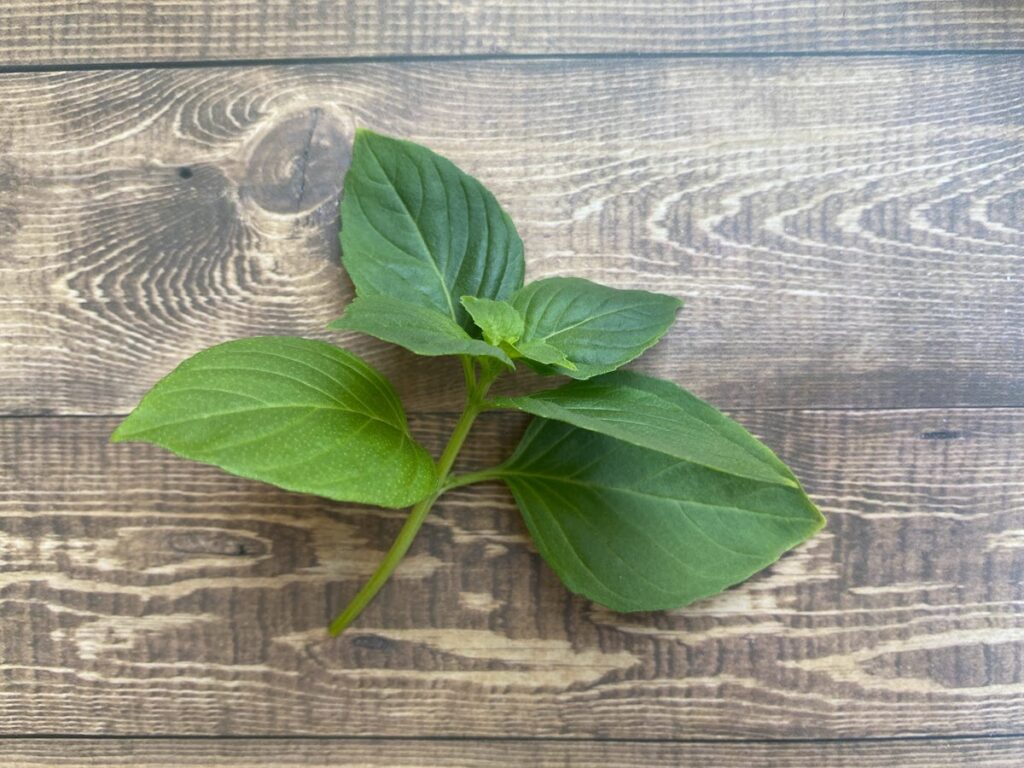
Sweet Dani Lemon Basil
As with Mrs Burns Lemon, Sweet Dani basil is a variety of Ocimum basilicum with a distinctive lemony aroma and taste.
Perpetuo Basil
Coming soon.
Types-of-Basil/Blue-Basil
African Blue Basil (Ocimum kilimandscharicum × basilicum ‘Dark Opal’)
A hybrid plant that’s a cross between Camphor basil (Ocimum kilimandscharicum) and Dark Opal Basil × (Ocimum basilicum ‘Dark Opal’). Despite camphor aromas, African Blue basil can go nicely in dishes such as pestos and salads. This plant is sterile and doesn’t produce seeds, meaning you need to grow it from cuttings.
Blue Spice Basil
One of the more fragrant types of basil, Blue Spice has a complex and pungent aroma that will add of clove, citrus, floral, and vanilla to your herb garden. Works well in teas and cocktails and sweet recipes.
Types-of-Basil/Asian-Thai-Basil (Asian and Thai Basils)
Thai Sweet Basil (O. basilicum var. thyrsiflora)
A cultivar of O. Basilicum native to southeast Asia, Thai basil has a dark purple stem and flowers, and small green leaves. In addition to sweet basil, Thai basil is widely available in many western supermarkets due to its widespread use in Asian-inspired dishes. The taste is more anise-like than Genovese basil, while still nicely sweet. Thai basil is is known as bai horapa/bai horapha in Thailand and Hun Que in Vietnam, and also sometimes (confusingly) called licorice basil (Persian basil is also sometimes called licorice basil) or cinnamon basil (a separate and different cultivar altogether).
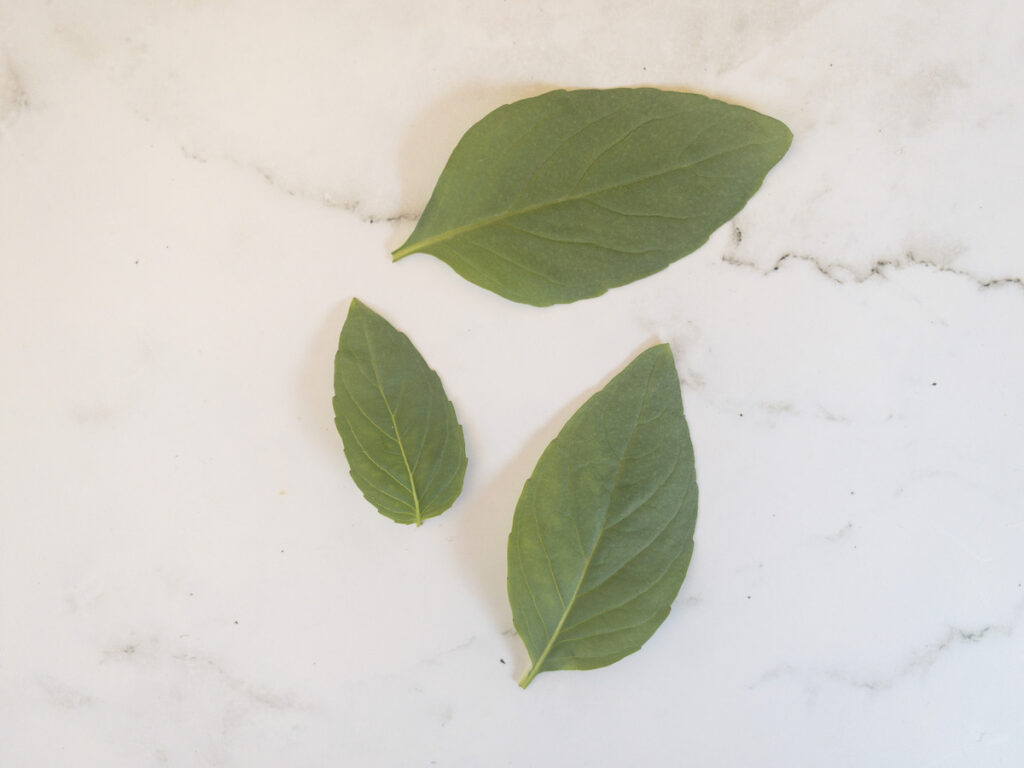
Siam Queen Basil (O. basilicum var. thyrsiflorum ‘Siam Queen’) and Queenette Thai Basil (O. basilicum var. thyrsiflorum ‘Queenette’)
Cultivars of Thai sweet basil.
Thai Holy Basil (Ocimum tenuiflorum)
Thai holy basil (bai ka-prao/bai ka-phrao in Thai) is spicier than Thai sweet basil, and is a different species all together (i.e. not o. basilicum).
Thai Lemon Basil (Ocimum × citriodorum ‘Lemon’)
Also known as mangluk in Thai.
International Basil Types
Cuban Basil (Ocimum basilicum ‘Cuban’)
Originating from Cuba, as the name suggests, Cuban basil has a similar taste as sweet basil, with a slightly spicier kick to it. Leaves are smaller than supermarket basil, and this variety of basil doesn’t flower frequently.
Puerto Rican Basil
As with Cuban basil originating from Cuba, Puerto Rican basil is native to Puerto Rico, and used in local dishes.
Persian Basil (O. basilicum ‘Persian’)
Wonderfully aromatic with notes of licorice and mint, Persian basil has longer and narrower beautiful silver-green leaves with mottled purple in the leaves, stems and veins.
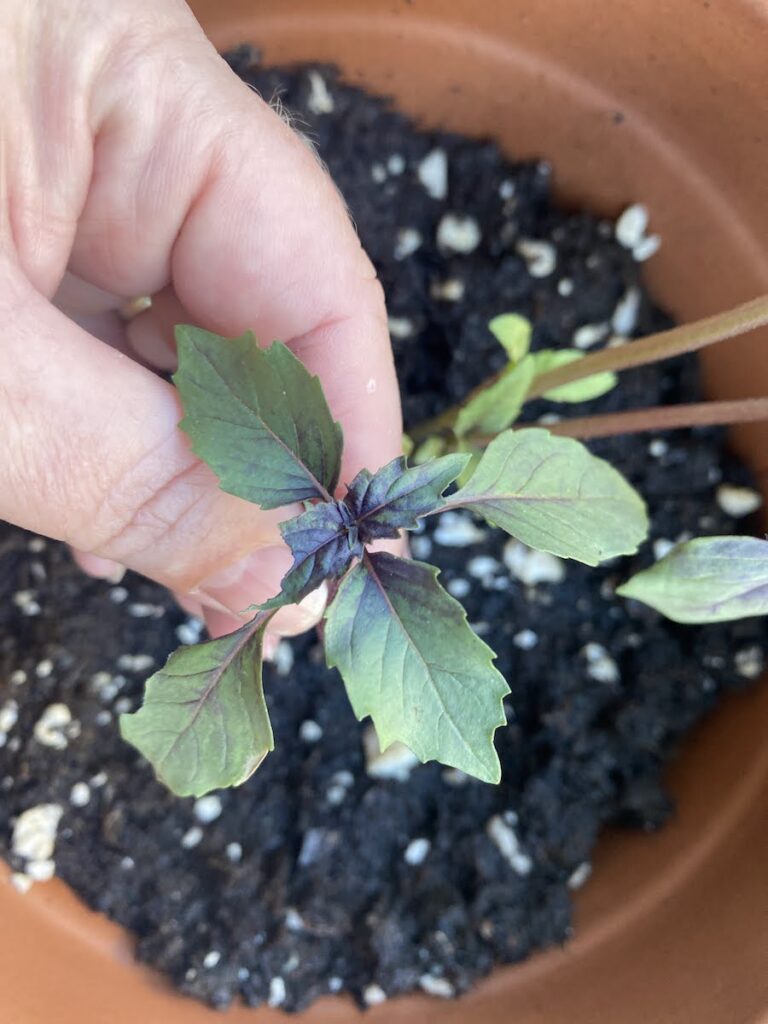
Egyptian Basil (O. Basilicum)
Egypt is one of the major suppliers of basil around the world, making Egyptian basil a source of basil, rather than a cultivar. If you’re purchasing Egyptian basil online or in a store, it is most likely to be O. basilicum, or regular sweet basil.
Ethiopian Basil
Coming soon.
Lesbos, Greek Columnar, and Aussie Sweetie Basil (Ocimum x africanum ‘Lesbos’ or Ocimum. x citriodorum ‘Lesbos’)
These are often referred to as the same plant, but as best as we can tell, Lesbos or Greek Columnar basil is Ocimum x africanum ‘Lesbos’ or Ocimum. x citriodorum ‘Lesbos’ and Aussie Sweetie is Ocimum basilicum ‘Aussie Sweetie’ – two different plants with remarkably similar characteristics. Both are non-flowering or very rare flowering, meaning growing from cuttings is the way to go.
French Basil / Marseille Basil
Coming soon.
Dwarf Basil or Bush Basil Plants (Ocimum minimum)
Pistou Basil / Ocimum basilicum ‘pistou’
Pistou basil is a type of dwarf basil, with a mild and sweet flavor with notes of anise and clove. It can be used in place of regular sweet basil across a range of recipes and uses, and gets its name from its widespread use in pistou sauce, a popular, pesto-like sauce from the Provence region of France.
Fine Leaf Basil (Ocimum basilicum v. minimum)
Coming soon.
Fino Verde Basil (O. basilicum piccolo)
Coming soon.
Boxwood Basil
Coming soon.
Greek Basil (ocimum Basilicum var minimum ‘Greek’)
Greek basil is sometimes also called dwarf basil as a general catch-all term (I checked with Click and Grow, and their Dwarf basil seed pods are Greek basil).
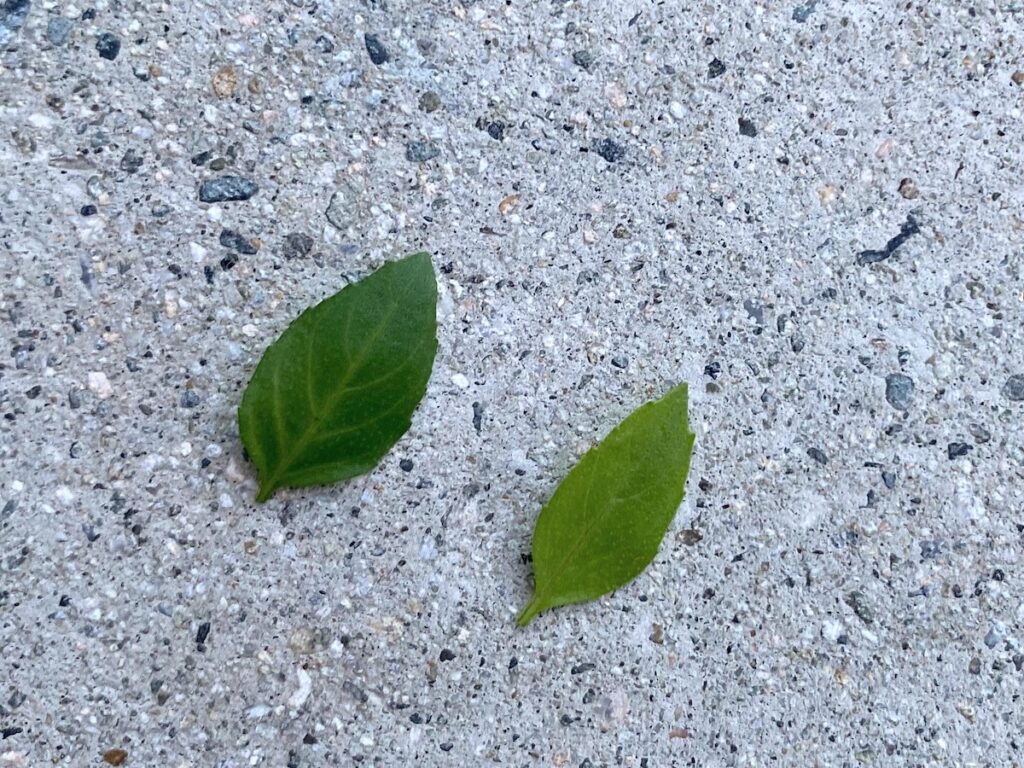
Spicy Globe Basil
Coming soon.
Globe Basil
Coming soon.
Spicy Bush Basil
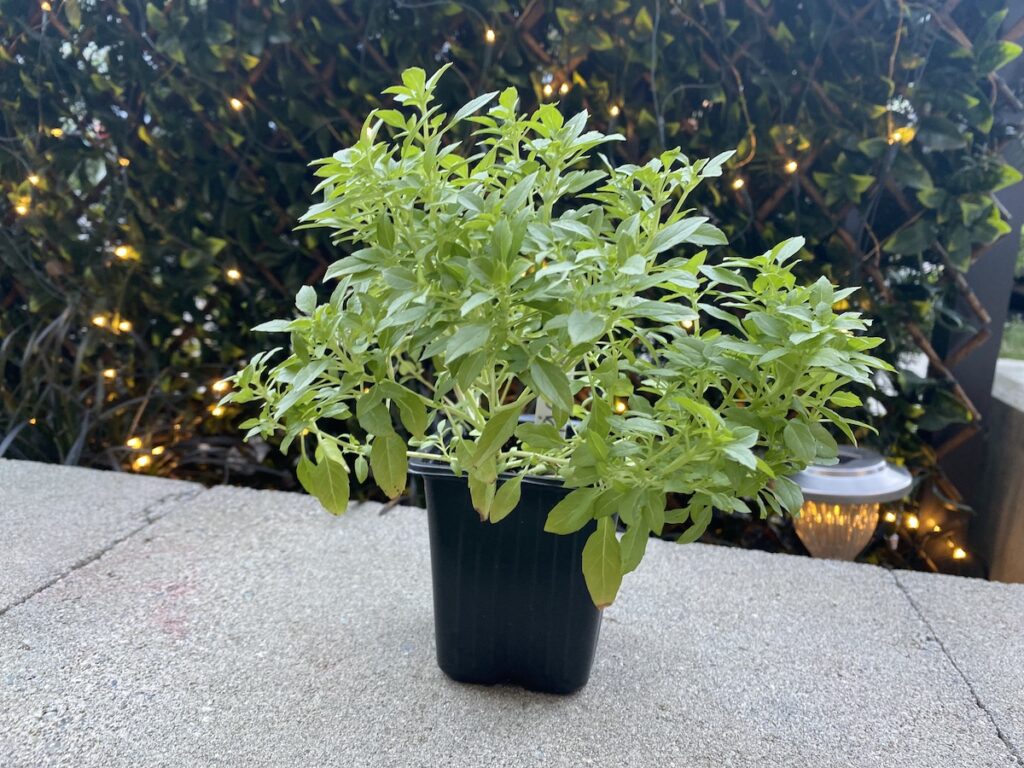
Coming soon.
Aristotle Basil
Coming soon.
Tree Basil
Coming soon.
Types of Holy Basil
Just as there are different cultivars or types of sweet basil, so are there different types of holy basil.
Krishna Tulsi (Ocimum tenuiflorum)
Used for medicinal purposes across India, Krishna tulsi has dark purple green leaves and a spicy, peppery taste.
Rama Tulsi (Ocimum sanctum)
With bright green leaves, this type of Tulsi has a milder taste compared to Krishna tulsi, and is commonly grown in home gardens in India. This is considered a cooling herb.
Vana Tulsi (Ocimum Gratissum)
Also known as forest basil or African basil, it’s used in India, Asia and Africa for medicinal uses, and grows wild in these regions.
Other Types of Basil
Cinnamon Basil (O. basilicum ‘Cinnamon’)
A cultivar of sweet basil, Cinnamon basil contains Methyl cinnamate within its leaves, giving it a distinct aroma and flavor of cinnamon from which it gets its name. Cinnamon basil often has dark green leaves with dark red or purple veins, purple stems, purple flowers, and a spicy flavor compared to most sweet basils that’s nice in fruit salads and baking. One nice thing about Cinnamon basil is it’s a fast propogator, so you can expect a big and regular harvest if you grow this in your herb garden.
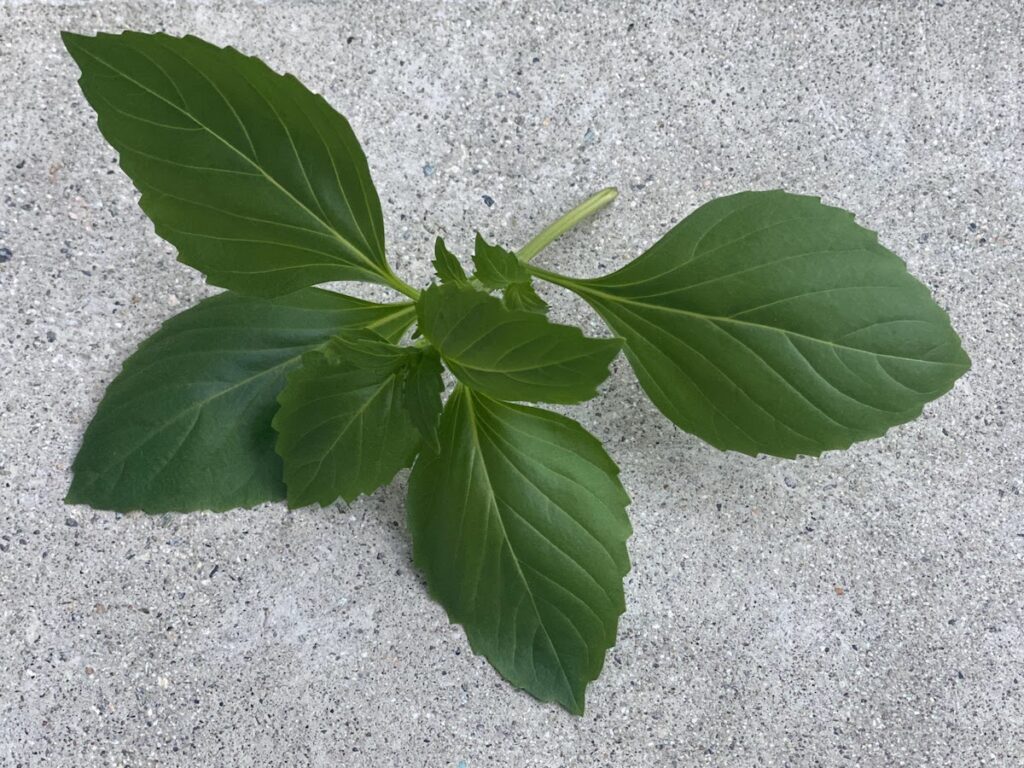
Nufar Basil (Ocimum basilicum ‘Nufar’)
Nufar is a commercial cultivar of sweet basil with a helpful quality: it’s resistant to fusarium wilt, which can be devastating to basil plants, and gardens more generally. If your herb garden has experienced fusarium wilt that you’ve struggled to get under control, this is a great option.
Christmas Basil (Ocimum basilicum ‘Christmas’)
A hybrid bred from Thai basil and Genovese basil, Christmas basil has fruity, pine notes and a pleasant taste and fragrance. It gets its name from its hardiness in some regions – surviving long after other basils have died off in the winter, until Christmas!
Cardinal basil
Even spicier than cinnamon basil, cardinal basil has brilliant dark purple flowers, making this a gorgeous ornamental, in addition to having culinary uses. Cardinal basil has a spicy clove flavor with notes of anise.
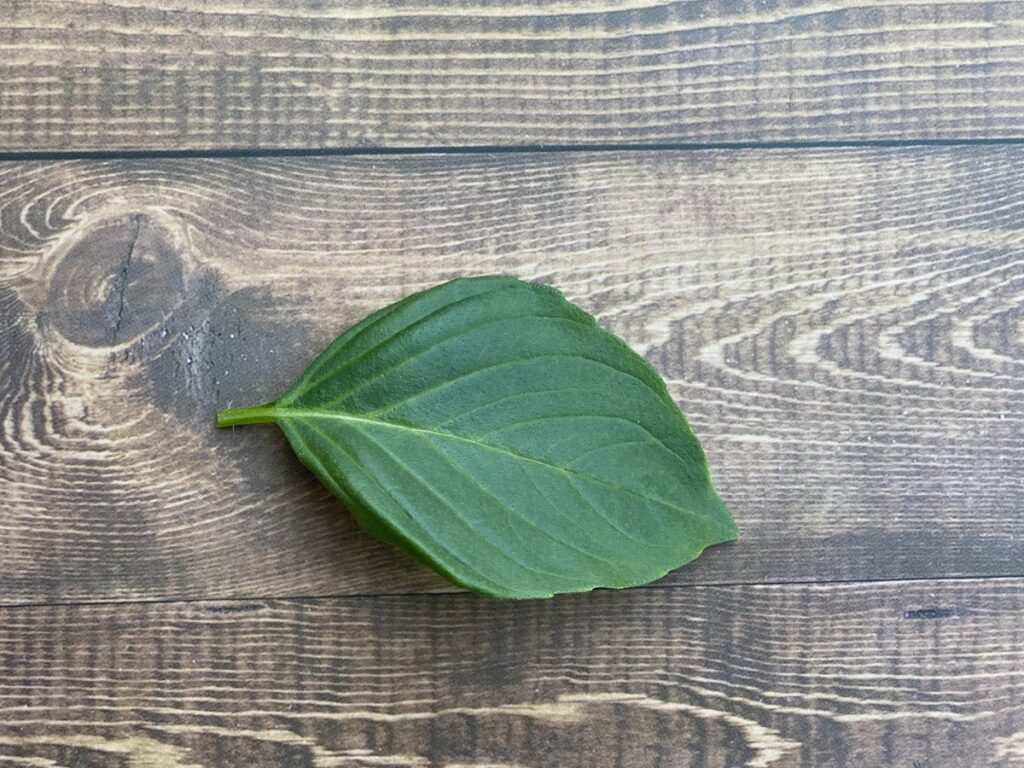
Aromatto basil
An ornamental basil with beautiful purple flowers, an aroma reminiscent of Cinnamon basil, and a sweet-spicy flavor. Often grown for use floral arrangements, but edible and nice as a garnish, too!
Magical Michael Basil
Coming soon.
Serata Basil
Coming soon.
Minette Basil
Coming soon.
Queen of Sheba Basil
Coming soon.
Clove Basil (Ocimum gratissimum)
Coming soon.
Summerlong Basil
Coming soon.
Spicy Saber Basil
Coming soon.
Round Midnight Basil
Coming soon.
Keep Reading About Different Basil Types
Cinnamon Basil vs Thai Basil: A Super Simple Guide to Figure Out the Difference
Cinnamon basil and Thai basil are two different cultivars of “normal basil,” but due to…
Ultimate Guide to Red Rubin Basil (Growing & Using it!)
If you are used to growing typical sweet or Genovese basil, you will be most…
Everything You Need to Know About Greek Basil (Growing & Using It!)
Greek basil is an interesting type of basil – both for growing and cooking with…
African Blue Basil Guide
If you are looking for an interesting basil to grow, which can be used as…
What Does Basil Taste Like?
While most of us have enjoyed the sweet smell and taste of fresh basil leaves…
Cinnamon Basil Guide
If you love to grow or cook with a range of different basil varieties, then…
Lime Basil Growing Guide
Lime basil (Ocimum Americanum or American Basil) offers fragrant citrusy leaves with a tangy fresh…
Thai Basil Growing Guide
Used widely in Southeast Asian cuisine, Thai basil is better for extended cooking than common…
Purple Basil Guide
If you have only ever grown green sweet basil, it could be time to branch…
17 Thai Basil Recipes to Try Tonight
You’ve spent the season growing Thai Basil and come up with a bountiful harvest. Now…
Everything You Need to Know About Lemon Basil
Lemon basil is a way for temperate climate growers, who cannot necessarily grow citrus fruits…
Lettuce Leaf Basil
If you love common basil, branching out into cultivating some different basil varieties is a…

